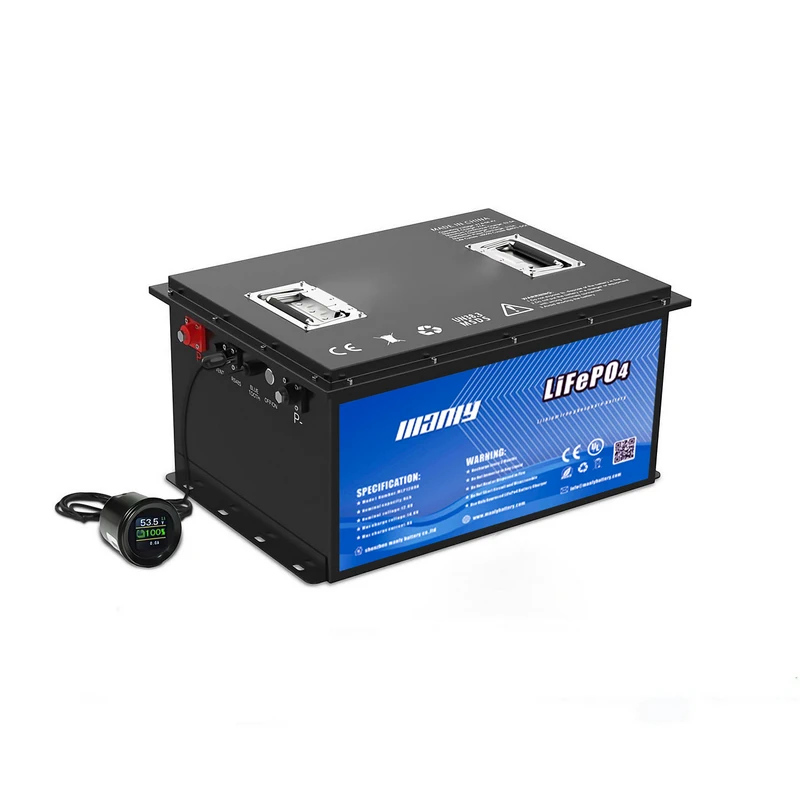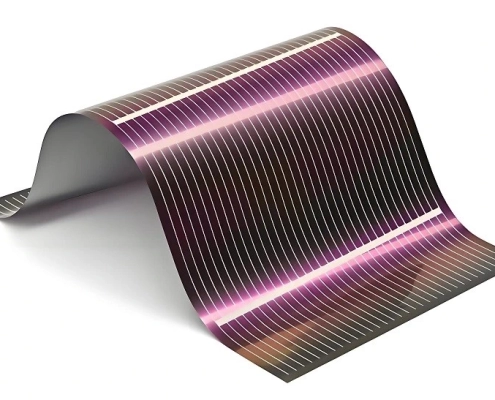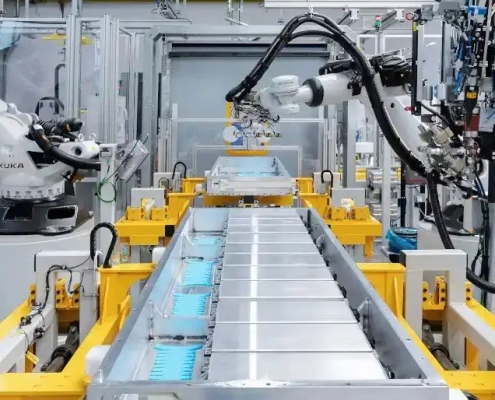2024 How Long Does Golf Cart Battery Last?
Table of Contents
- 2024 How Long Does Golf Cart Battery Last?
- Overview of Golf Cart Battery Lifespan
- How Long Do Different Types of Golf Cart Batteries Last
- Common Misconceptions About Golf Cart Batteries
- Essential Maintenance Tips for Your Golf Cart Battery
- How to Properly Store Your Golf Cart Battery
- Key Signs Your Golf Cart Battery Needs Replacing
- Choose Reliable Brands for Longer Golf Cart Battery Life
- Conclusion
- Learn More About Battery
Choosing the correct golf cart battery is essential for maximizing your cart’s performance and longevity. The battery brand you select plays a significant role in this and understanding the different golf cart battery types available. Whether you opt for traditional lead-acid batteries or the increasingly popular lithium batteries for golf cart use, your maintenance and care are crucial. This section will explore how selecting a reliable battery brand and following best practices can extend your battery’s life and keep your golf cart running smoothly.
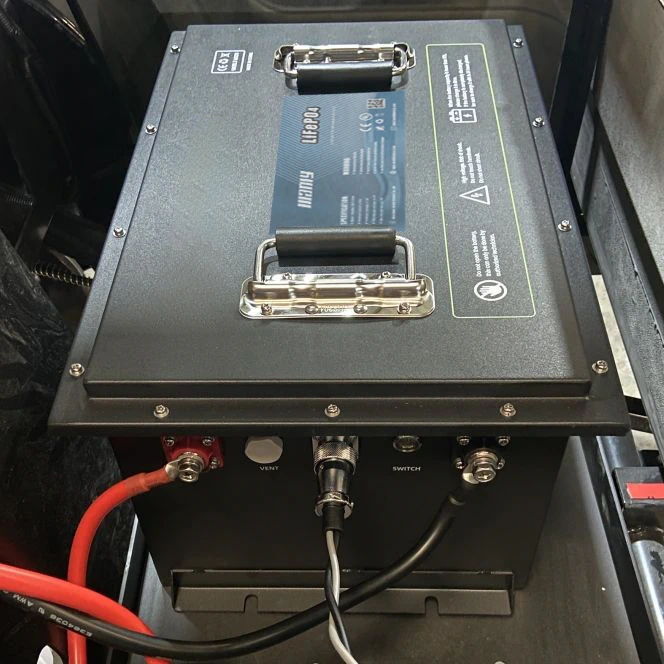
Overview of Golf Cart Battery Lifespan
Factors Affecting Lifespan
The golf cart battery lifespan is influenced by several factors, with maintenance being critical. Your responsibility in properly caring for your battery, such as keeping it charged and maintaining the correct water levels, can significantly extend its life. On average, a well-maintained golf cart battery for personal use can last 6 to 10 years. However, if the battery is poorly maintained or frequently left in a discharged state, its lifespan could be much shorter.
Usage Patterns
Understanding how often you use your golf cart is crucial, as it significantly affects your battery’s lifespan. For instance, batteries in golf carts that are part of a golf course fleet, which might be used for 2-3 rounds of golf daily during peak season, typically last about 4 to 6 years. In contrast, batteries in privately owned carts, which may only be used for 3-5 rounds per week, often have a longer lifespan, sometimes up to 10 years.
Impact of Cart Accessories
The type of accessories on your golf cart, like headlights, taillights, or speed enhancements, can also affect the golf cart battery life. These accessories draw additional power from the battery, which may reduce the lifespan if not managed properly. One way to manage this is by regularly checking and balancing the battery’s charge. Balancing the charge involves ensuring that each cell in the battery has a similar charge level, which can help mitigate the effects of accessory use on the battery’s lifespan.
Location and Usage Frequency
If you live on or near a golf course and frequently use your cart for commuting and golfing, this can put extra strain on the battery. Regular use under these conditions may shorten the battery’s life, similar to the wear seen in fleet golf carts.
In summary, the lifespan of golf cart battery types varies widely depending on maintenance, usage patterns, and accessory load. However, with your understanding and commitment to proper care and mindful usage, you can significantly extend the life of your lithium batteries for golf carts or other battery types.
How Long Do Different Types of Golf Cart Batteries Last
Lead-Acid Batteries
Lead-acid batteries are a cost-effective choice that has been a staple in golf carts for years. These batteries are straightforward to maintain, but their lifespan is shorter, typically 2 to 5 years. Their significant weight can also impact your cart’s performance, particularly in speed and range. Keeping them charged regularly and monitoring the water levels is crucial to extend their life.
AGM Batteries
Absorbed Glass Mat (AGM) batteries, an advanced version of lead-acid batteries, are designed for durability. They charge more quickly and are leak-resistant, which helps avoid corrosion. With a lifespan of 4 to 7 years, they offer better durability. However, they come with a higher price tag, reflecting their enhanced features and lower maintenance requirements.
Gel Batteries
Gel batteries use a thick gel to suspend the electrolytes, providing a leak-proof design that works well in extreme temperatures. These batteries usually last 5 to 7 years and are particularly effective in colder climates where other batteries may not perform well. One downside is that they charge slower than AGM batteries, which might be a factor depending on how often you use your cart.
Lithium-Ion Batteries
Lithium batteries for golf cart use are gaining popularity due to their many benefits. These batteries are lightweight and compact, which improves your cart’s overall performance. They have the longest lifespan, often lasting more than 10 years, and with good care, they can reach up to 20 years. Unlike other types, lithium ion batteries require minimal maintenance, and their low self-discharge rate means they can hold a charge for a long time, making them perfect for occasional use.
Lithium Iron Phosphate batteries
also known as LiFePO4 batteries, are renowned for their high energy density and long lifespan. These batteries typically last between 8 to 12 years, or approximately 1,700 to 3,500 hours of operation. They are highly stable, making them a safe and reliable option for golf carts. Additionally, LiFePO4 batteries perform well in various temperatures, making them a versatile choice for different climates. Their durability, low maintenance needs, and a longer lifespan make them an excellent investment for those seeking a long-term solution.
Summary Points
- Lead-acid batteries: Affordable, lasting 2 to 5 years, heavy, and requiring regular maintenance.
- AGM batteries: More durable with a 4 to 7-year lifespan, quicker charging, and leak-resistant but more expensive.
- Gel batteries: These are great for extreme temperatures and have a 5—to 7-year lifespan. They are slower to charge and ideal for cold climates.
- Lithium-ion batteries: For the last 10+ years, lithium-ion batteries have been lightweight and require little maintenance. They have a higher initial cost but are cost-effective in the long run.
- Lithium Iron Phosphate (LiFePO4) batteries: Highly stable, have a lifespan of 8 to 12 years, low maintenance, and perform well in various temperatures.
Understanding the various golf cart battery types and their respective lifespans can help you choose the best option for your golf cart. Proper care and selecting the right battery type will ensure long-lasting performance for your cart.
Common Misconceptions About Golf Cart Batteries
Misconception 1: Deep Discharge Won’t Harm Your Battery
One of the biggest misconceptions about lithium batteries for golf cart use is that it’s okay to let the battery discharge to deficient levels, such as 10% or 20%, before recharging. However, doing this regularly can shorten the battery’s lifespan. When the charge level drops too low, the chemicals inside the battery become less efficient, which can stress the battery and gradually degrade its electrodes. This can ultimately reduce the battery’s overall lifespan. It’s better to recharge the battery before it reaches such low levels to ensure it lasts as long as possible.
Misconception 2: Fully Charging Before Long-Term Storage is Best
Another common myth is that you should charge your golf cart battery to 100% before storing it for an extended period, such as over the winter. While this may seem logical, it can harm the battery if fully charged for months. The battery’s electrodes can become strained when sitting at full charge for long periods, which may degrade the material and reduce the battery’s life. Instead, charging the battery to around 50-80% before storing it is better. Some golf carts have intelligent systems to help manage this process, so it’s a good idea to check your manual or consult your dealer.
Misconception 3: Frequent Charging Wastes Battery Cycles
Many believe charging their golf cart battery frequently, even when it’s not fully depleted, will waste the battery’s life cycles. However, lithium-ion batteries are different. These batteries are rated by complete cycles—from 100% charge down to 0% and back up. Partial charges, such as topping off from 80% to 100%, only count as a fraction of a cycle. Regularly keeping the battery’s charge level high is better for its longevity.
Misconception 4: Accessories Drain Your Battery Significantly
Some believe adding accessories like sound systems or LED lights will drastically reduce the battery life or the distance a golf cart can travel on a single charge. While these accessories do draw power, the amount is usually minimal compared to what the motor uses. For example, a sound system might draw only a tiny fraction of the energy that the motor requires, so you’re unlikely to notice a significant impact on your cart’s range.
Misconception 5: Lithium-Ion Batteries Are Prone to Explode
There’s a lingering fear that lithium-ion batteries in golf carts might catch fire or explode, especially if stored indoors. While it’s true that some types of lithium batteries, like lithium cobalt oxide, can be more volatile, lithium batteries for golf cart use are usually lithium iron phosphate (LiFePO4). These batteries are far more stable and include a Battery Management System (BMS) that monitors and controls charge levels, temperature, and other factors to prevent dangerous situations. The BMS greatly reduces the risk of thermal runaway, making these batteries safe and reliable for everyday use.
By understanding and debunking these misconceptions, you can take better care of your golf cart battery. This will extend its life and ensure it performs well over time, keeping your golf cart running smoothly.
Essential Maintenance Tips for Your Golf Cart Battery
Maintaining your golf cart battery properly is vital for its longevity and consistent performance. Below are steps to help you care for different golf cart battery types effectively.
Proper Charging Practices
- By following these proper charging practices, you can avoid overcharging, cell damage, and the drying out of the battery. This will reduce the frequency of water refills and prevent unnecessary stress on the battery, giving you confidence in your maintenance routine.
- Prevent Deep Discharges: It’s equally important to avoid letting your battery discharge completely. Aim to keep the battery charged to at least 50% and avoid letting it drop below 20%. Adhering to the specific charging guidelines from your battery brand can help extend the battery’s life.
Store in Warm Conditions
- Temperature Control: Most golf cart batteries, aside from gel types, are sensitive to cold weather, which can drain their charge. Store your golf cart in a warm environment, like a heated garage, to prevent this. If you need to store the cart during winter, use a trickle charger to keep the battery charged without risking overcharging.
Reduce Battery Stress
- Flat Routes Preferred: When possible, choose flat routes over steep hills. Driving up hills uses more power and can quickly drain the battery, shortening its lifespan. By sticking to smooth, level paths, you can minimize the load on your battery and ensure it lasts longer.
Routine Battery Inspections
- Monthly Checks: Inspect lead-acid batteries every month to ensure the water level is at the fill line. If your battery doesn’t require water, check for visible damage and periodically test the voltage.
- Refilling with Water: Maintaining the correct water level is essential for lead-acid batteries. Charging can cause the water inside to evaporate, leaving important components exposed. To refill:
- Open the battery cap carefully.
- Locate the fill line.
- Add distilled water until the level is slightly above the plates.
- Only use distilled water to avoid introducing impurities.
Following these maintenance tips will help you keep your golf cart battery—a lead-acid or one of the newer lithium batteries for golf cart use—in top condition. Regular care and maintenance will ensure your battery performs well for many years, protecting your investment and keeping your cart running smoothly.
How to Properly Store Your Golf Cart Battery
Storing your golf cart battery correctly is critical to maintaining its longevity and ensuring your golf cart is always ready to go. Each type requires specific care, whether you have a lead-acid or lithium battery.
Storing Lead-Acid Batteries
Lead-acid batteries need careful attention when it comes to storage. Here’s how to do it:
- Total Charge: Before storing, ensure your lead-acid battery is fully charged. This process can take 8 to 10 hours. Charging overnight in a well-ventilated area is ideal.
- Regular Inspections: Periodically inspect the battery for corrosion or dirt. Clean the battery and connections using a bristle brush and a solution of baking soda and water. Keeping the battery clean and dry is essential to prevent damage.
- Maintain Charge Levels: Try to use the battery regularly, but avoid discharging it beyond 80%. If the battery drops below this level, recharge it as soon as possible to maintain health.
Storing Lithium Batteries
Lithium batteries for golf cart use are generally easier to store than lead-acid batteries. They require less maintenance and have better cold tolerance. Here’s what you need to do:
- Ideal Storage Conditions: Store lithium batteries where the temperature is above freezing and 28°C. Prolonged exposure to freezing temperatures can reduce battery capacity, slow charging, and shorten run times.
- Fully Charge and Unplug: Charge your lithium battery fully before storage, then unplug it. Lithium batteries discharge much slower than lead-acid batteries, and a fully charged lithium battery can maintain its charge for up to 6 months.
- Clean and Dry: Before storage, wipe the battery with a lightly dampened cloth to clean it. Ensure the battery is completely dry before storing, as any leftover moisture can freeze and damage the battery.
- Monthly Check: Check the battery’s state of charge monthly. If the charge drops to half or below, recharge it to maintain optimal battery health.
EZ GO Lithium Battery Storage
Storing an EZ GO Elite lithium battery golf cart is straightforward:
- Adjust Charge Level: Ideally, keep the charge level around 90%. If the battery is 100%, use the cart slightly to reduce the charge.
- Switch to Tow Mode: After adjusting the charge, switch the golf cart to “Tow” mode to kill the system’s power. This prevents unnecessary battery drain during storage.
- Cover and Store: Once in tow mode, cover the golf cart for protection. When you return, you can recharge the battery to complete, and it will be ready for use.
Properly storing your golf cart battery ensures that it remains in good condition and is ready to deliver reliable performance when needed. Whether you’re using lead-acid or lithium batteries for your golf cart, following these steps will help extend the life of your battery.
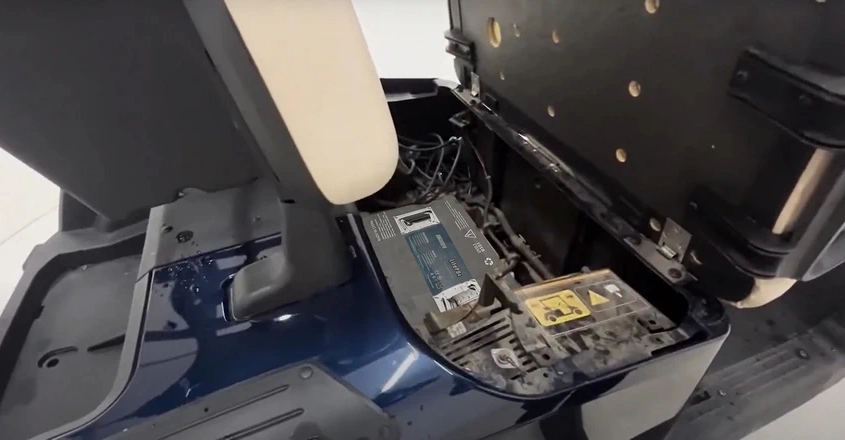
Key Signs Your Golf Cart Battery Needs Replacing
When it comes to maintaining your golf cart, knowing when to replace your golf cart battery is crucial. Here are some key signs to watch for:
Reduced Range and Power
- Shorter Rides: If your golf cart doesn’t travel as far on a single charge as it used to, it indicates that the battery’s capacity is diminishing. Reliable golf cart batteries should provide consistent power, so if you notice a decrease, it might be time for a new battery.
- Slow Acceleration: A noticeable drop in acceleration, especially when going uphill or carrying a load, can signal that your battery is failing. This not only affects the performance of your golf cart but also poses a safety risk. Lithium batteries for golf cart use are designed to maintain power even under load so that any decline could indicate a need for replacement.
Longer Charging Times
- Extended Charging Periods: If your battery takes much longer or never seems to reach a full charge, it’s likely nearing the end of its life. A good battery brand, such as Trojan or MANLY Battery, should offer a battery that charges efficiently and holds its charge well.
- Frequent Recharging: Recharging your battery more often than before is another sign that its capacity is diminishing.
Physical Signs of Wear
- Corrosion: Excessive corrosion on the battery terminals can impact performance. While some corrosion is typical, a buildup that interferes with battery function is a sign of trouble. Choosing a high-quality battery brand can help prevent this issue.
- Swelling or Leaking: Any signs of swelling, cracking, or leaking immediately indicate that the battery needs to be replaced. Ignoring these physical changes can be hazardous and may damage your golf cart.
Unusual Noises or Smells
- Hissing Sounds: If you hear hissing or bubbling noises during charging, this could indicate internal damage to the battery. It’s a sign that the battery may not last much longer.
- Foul Smell: A strong sulfur smell from the battery, like rotten eggs, is a sign of a leak or other serious issue. Due to their advanced design, high-quality lithium batteries for golf cart applications typically avoid these problems.
By looking for these signs, you can ensure your golf cart remains reliable and efficient. When it’s time to replace your battery, remember that choosing the right, high-quality battery brand can make all the difference in performance and longevity, giving you peace of mind in your decision.
Choose Reliable Brands for Longer Golf Cart Battery Life
Importance of Choosing the Right Battery Brand
The brand you choose is crucial in ensuring a long-lasting golf cart battery. Reliable battery brands like MANLY Battery offer high-quality lithium batteries for golf cart use and are known for their durability and performance. With over 13 years of expertise in battery manufacturing, MANLY stands out by offering batteries that last longer and have advanced safety features and global certifications, such as UN38.3 and CE.
Advantages of Golf Cart Lithium Batteries
Opting for lithium batteries for golf cart applications from a trusted battery brand can significantly extend the life of your golf cart. For instance, MANLY’s 48V lithium golf cart battery provides a range of options that can support different usage needs, from 50Ah to 150Ah capacities. These batteries are lightweight and offer a longer lifespan—up to 10 to 15 years—compared to traditional lead-acid batteries. They charge faster, typically taking just 3 to 5 hours, and support deep discharge, ensuring consistent power output.
Custom Solutions for Diverse Needs
Top battery brands like MANLY also offer customization options, allowing you to tailor the battery to your golf cart needs. Whether you need a battery that performs well in extreme temperatures or supports additional features like Bluetooth connectivity, choosing a reliable brand ensures you get a product that meets your expectations and provides long-term value.
Enhanced Performance with Lithium Technology
Switching to lithium batteries for your golf cart boosts its overall performance and reduces maintenance costs. MANLY’s batteries, for example, have a 95% energy efficiency rate, outpacing the 70% efficiency of traditional lead-acid batteries. This means faster charging, lower energy consumption, and less frequent replacements—saving you money in the long run.
Key Takeaways
- Choose a reliable battery brand: Opting for a trusted brand like MANLY ensures you get high-quality, long-lasting batteries, giving you the peace of mind that your golf cart will always be ready for the game.Benefit from lithium technology: Lithium batteries for golf cart use offer longer lifespans, faster charging, and better efficiency, relieving you from the hassle of frequent replacements and ensuring your golf cart is always ready when you are.Customization options: Reliable brands provide tailored solutions to meet your specific needs.
- Long-term savings: High-quality batteries reduce the need for frequent replacements and lower overall maintenance costs, ensuring that your investment in a reliable battery brand like MANLY pays off in the long run. Selecting the right battery brand for your golf cart is a crucial decision that impacts the longevity and performance of your golf cart battery. Choosing a trusted brand ensures that your golf cart remains reliable and efficient for years.
Conclusion
In summary, the longevity and efficiency of your golf cart battery depend on choosing the right battery brand and maintaining it properly. Lithium batteries for golf cart use, especially those from trusted brands, offer superior performance and durability. By understanding the importance of regular maintenance, selecting the correct battery type, and opting for high-quality products, you can ensure your golf cart remains reliable for years to come. Investing in a quality battery is not just about immediate performance; it’s about long-term savings and peace of mind, thanks to the high reliability of these products.

